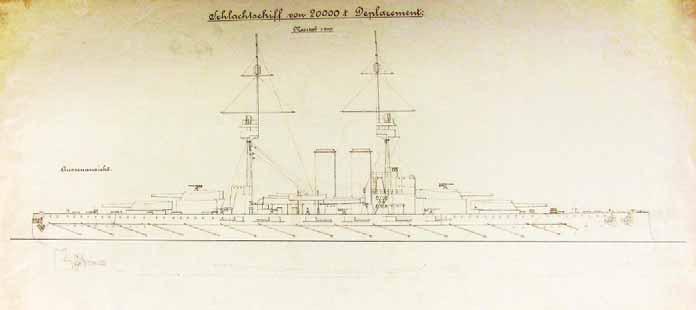ships would have been the enlarged copies of the British Queen Elizabeth class fast battleships. Most probably the units of the Francesco Caracciolo class were the “super-dreadnoughts” in the 1913 October article of the “Neue Freie Presse” which criticized the Navy’s 24,500 ton battleship design.393 Political and Financial Background The struggle of the Navy for securing the money for the new battleship class started in March 1912. Marinekommandant Admiral Rudolf von Montecuccoli presented a very ambitious (in fact, the most ambitious in the history of the Navy) program in March 1912: he asked a grant of 464 million Kronen. This sum would have allowed the construction of four 24,500 ton battleships, five cruisers, a dozen destroyers, six submarines, three colliers, a new 40,000 ton floating dock, four Danube monitors and four Danube patrol boats. The Emperor, Franz Joseph was realist and advised him to present his program at a more favorable time.394 At the 9 July meeting of the common Council of Ministers, Montecuccoli asked only 24 million Kronen for starting the construction of one new battleship. The Hungarian members, Prime Minister László Lukács and Finance Minister János Teleszky, rejected even this modest sum. On 3 October, Montecuccoli asked 170 million Kronen for the construction of two 24,000 – 25,000 ton battleships. On 8 October, Lukács and Teleszky told him that they would assent to the costs of the new class only if the precedent one would be paid, but they promised to bring forward the payment from 1916 to 1914. The Hungarian government approved only the construction of two colliers.395 Anton Haus as the newly appointed Flotteninspektor on 25 July 1912 visited Franz Ferdinand in Chlumetz. At this introductory meeting, the Heir of the Throne expressed his wish to start the building of the new battleships as soon as possible. He told Haus to convene a common Council of Ministers and to build the battleships even if financing was “from the air”.396 In February 1913, the old and compromised Montecuccoli was succeeded by Anton Haus. In March 1913, Archduke Franz Ferdinand, who wanted to repeat the method to start the construction at the formal own risk of the shipyard STT
before the voting on the expenses of the battleships like in the case of the Tegetthoff class, urged Haus to order the new dreadnoughts secretly without informing the Austrian and Hungarian politicians.397 Despite the great pressure from the Archduke, Haus did not want to go behind the backs of the politicians and in April he started negotiating with Austrian and Hungarian ministers on this method of building. On 18 April 1913, the STT, the Škoda Works and the Witkowitz Ironworks in a joint letter offered to start the construction of a battleship on designs provided by the Navy at their own risk. The three firms asked for orders, claiming otherwise they should begin to dismiss qualified employees from the second half of the year. In the official documents this method was called “Spekulationsbau”. The Navy made two preliminary draft replies. The first was an enthusiastic version for the case if both governments would assent to the building at formal own risk. The first line of this variant is the following: “My predecessor already expressed before the delegations in December 1912 that the Monarch class should be replaced with dreadnoughts.” According to this variant the Navy would have provide the three firms with the plans of the 24,500 ton battleship for price calculation. The second version was less enthusiastic. In this variant the Navy emphasized that under the circumstances they could not give an order or could not make a commitment. Both variants included a paragraph which called the attention of the three firms to the orders to be provided for the Hungarian industry.398 On 20 April 1913, Haus met Lukács in Vienna and gave him an exemplar of the abovementioned letter of 18 April and the less enthusiastic version of the preliminary draft reply. The Hungarian Prime Minister thanked the fairness of Haus. Lukács told Haus that he was hearing rumors of this matter since a month, and the members of his cabinet were very anxious about this matter. Haus felt that he was justified and the secret-mongering pressed by the Heir of the Throne was a blunder. The common ministers, common War Minister Krobatin, common Foreign Minister Berchtold and common Finance Minister Biliński supported the plan of building at the formal own risk, but the Austrian Prime Minister Stürgkh and Finance Minister Zaleski were not too enthusiastic. Zaleski
— 115 —






























